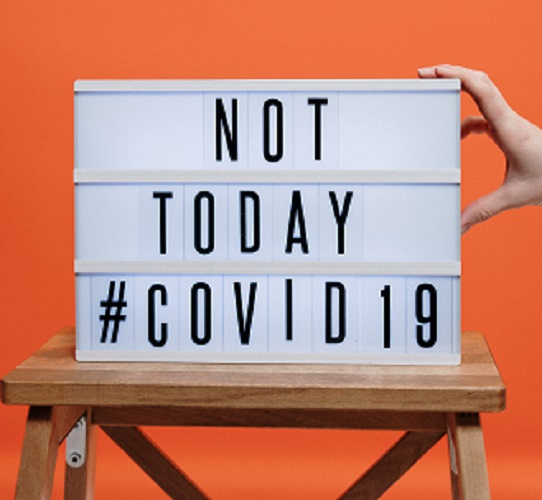By Intisar Seraaj

The CDC says. “If soap and water are not readily available, use an alcohol-based hand sanitizer with at least 60% alcohol.” | Photo by cottonbro from Pexels.
There’s a strong common understanding about how important literacy is. In the U.S., only about 14% of the entire adult population is illiterate and the U.S. ranks 16th in the world for adult reading skills, according to CreditDonkey, a credit card comparison website. However, there are several types of literacy, including financial literacy, digital literacy, and health literacy.
Around the world, October is Health Literacy Month, which was founded in 1999 to promote the importance of understandable health information. Health literacy is “the degree to which individuals have the capacity to obtain, process, and understand basic health information and services needed to make appropriate health decisions” for themselves and their families. This pandemic has shown just how important health literacy is.
Health literacy data varies, but according to the Center for Health Care Strategies, “about 36% of adults in the U.S. have low health literacy, with disproportionate rates found among lower-income individuals, medically underserved people, older adults, and minority groups. Only 10% of Americans can truly make sense of and use health information they’re given, like instructions when leaving the hospital.” That can be dangerous! Low health literacy can lead to:
- medical and medication errors
- increased illness and disability
- compromised public health
- misunderstanding instructions about prescription medication and poor comprehension of nutrition labels
- poorer health status and decreased likeliness of using preventative care
- post-surgical infection
- longer hospitalization and an increased rate of minor complications
- death

Washing your hands is easy, and it’s one of the most effective ways to prevent the spread of germs. The CDC recommends scrubbing your hands for at least 20 seconds when washing.| Photo by Vova Krasilnikov from Pexels.
Thus, low health literacy impacts a person’s understanding of public health precautions, according to RACmonitor, an online source helping healthcare providers make informed decisions. So, there’s less comprehension of how the virus spreads, its key symptoms and effects, and why it’s important to follow coronavirus health and safety precautions. Populations with low health literacy are less likely to engage in crucial healthy actions that diminish the spread of the virus such as regular and thorough handwashing, efficient social distancing, and proper masks wearing. The University of North Carolina at Chapel Hill created an interactive map to show users health literacy levels in the U.S. Click here to see what your state, county, and city stand with health literacy levels.
It’s not entirely the fault of adults who have lower health literacy. For example, the Black community suffers from low health literacy rates but historically has had poorer access to health care and received services of lower quality than does the general population. Furthermore, there’s a deep distrust of government and health care institutions in the Black community, muddling efforts to alleviate the pandemic’s impact. This is due to countless cases of racist medical experimentation like the 40-year Tuskegee syphilis study in which 600 Black men in rural Alabama were studied for but denied treatment for syphilis, the ongoing case of Henrietta Lacks in which Lacks’ cells were unknowingly harvested and used (and are still being used) in medical research, and the experimentation was done on enslaved Black women without anesthesia by “the father of modern gynecology.”
Bridgette Stasher-Booker, Ph.D. is the Chair/Program Director for Health Information Management and an associate professor at Alabama State University, and a board member for Seraaj Family Homes, Inc. Booker says doctors and health professionals can start regaining the confidence of patients who have medical anxiety by understanding the population they serve. “Visit the local schools, churches, civic groups, etc.,” Booker says. “Just serving a group of patients is not the only step to building trust and reducing misconceptions about health care. Get involved! Go back to the foundation of the field and make house calls.”
In addition to the justified distrust of the health system, entities providing health services and information have the duty to assist populations in overcoming low health literacy by simplifying information and making it more accessible. The Centers for Disease Control and Prevention (CDC) provides tools for such improvements. Here are some easy improvements organizations can make:
- using pictures to improve health communication
- making orally delivered health information accessible and actionable
- using headings to help readers scan and find information
- using narrative communication such as anecdotes, quotations, examples, vignettes, and personal stories to explain statistics and topics
- chunking information to improve audience comprehension and recall
- explaining risks and numbers by using numbers rather than words alone and keeping denominators and time frames the same when making comparisons
- understanding success in communication must be measured not only by what recipients know but by how they feel
However, it’s not all on the shoulders of the healthcare system. “When people actively get involved during their doctor visits, they are more likely to be satisfied, follow recommendations, and get better results,” according to the CDC. Booker suggests getting to know your doctor and their staff. “Second, keep track of your visits and document any cancellation, change of clinicians, and the various services you receive,” Booker says. “Third, jot down notes and health encounters to discuss with your doctor. Do not let them rush you through your visit. Ask questions. Fourth, access your patient portal. Lastly, hold yourself and the clinical accountable for understanding how to take care of you and improve your healthcare.” Depending on the type of doctor’s visit you’re having, here are some questions to get started with being more involved in your healthcare process:
- Do I need to change my daily routine?
- What do I do if the medicine causes problems or doesn’t seem to work?
- What will the results of my test tell me?
- What are my other treatment options and what are the benefits of each option?
- How often do you perform this surgery?
- What will I be able to do or not do after the surgery and how might I feel afterward?
Furthermore, the responsibility is on entire countries to actively strive to increase people’s health literacy. Good health literacy better prepares persons and communities for emergency situations like COVID-19 outbreaks and lowers the likelihood of such outbreaks becoming full-blown pandemics. Having a good level of health literacy helps reduce the risk of infection and contagion and improves understanding of our social responsibility for disease prevention. “Understanding pandemics and how it affects a person, clinicians and aspects of the community is important in advocating for a better future,” Booker says. Health starts at home.

